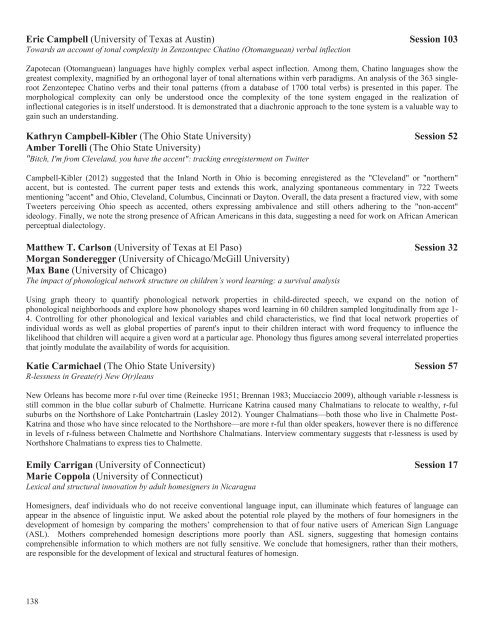here - Linguistic Society of America
here - Linguistic Society of America
here - Linguistic Society of America
Create successful ePaper yourself
Turn your PDF publications into a flip-book with our unique Google optimized e-Paper software.
Eric Campbell (University <strong>of</strong> Texas at Austin) Session 103Towards an account <strong>of</strong> tonal complexity in Zenzontepec Chatino (Otomanguean) verbal inflectionZapotecan (Otomanguean) languages have highly complex verbal aspect inflection. Among them, Chatino languages show thegreatest complexity, magnified by an orthogonal layer <strong>of</strong> tonal alternations within verb paradigms. An analysis <strong>of</strong> the 363 singlerootZenzontepec Chatino verbs and their tonal patterns (from a database <strong>of</strong> 1700 total verbs) is presented in this paper. Themorphological complexity can only be understood once the complexity <strong>of</strong> the tone system engaged in the realization <strong>of</strong>inflectional categories is in itself understood. It is demonstrated that a diachronic approach to the tone system is a valuable way togain such an understanding.Kathryn Campbell-Kibler (The Ohio State University) Session 52Amber Torelli (The Ohio State University)"Bitch, I'm from Cleveland, you have the accent": tracking enregisterment on TwitterCampbell-Kibler (2012) suggested that the Inland North in Ohio is becoming enregistered as the "Cleveland" or "northern"accent, but is contested. The current paper tests and extends this work, analyzing spontaneous commentary in 722 Tweetsmentioning "accent" and Ohio, Cleveland, Columbus, Cincinnati or Dayton. Overall, the data present a fractured view, with someTweeters perceiving Ohio speech as accented, others expressing ambivalence and still others adhering to the "non-accent"ideology. Finally, we note the strong presence <strong>of</strong> African <strong>America</strong>ns in this data, suggesting a need for work on African <strong>America</strong>nperceptual dialectology.Matthew T. Carlson (University <strong>of</strong> Texas at El Paso) Session 32Morgan Sonderegger (University <strong>of</strong> Chicago/McGill University)Max Bane (University <strong>of</strong> Chicago)The impact <strong>of</strong> phonological network structure on children’s word learning: a survival analysisUsing graph theory to quantify phonological network properties in child-directed speech, we expand on the notion <strong>of</strong>phonological neighborhoods and explore how phonology shapes word learning in 60 children sampled longitudinally from age 1-4. Controlling for other phonological and lexical variables and child characteristics, we find that local network properties <strong>of</strong>individual words as well as global properties <strong>of</strong> parent's input to their children interact with word frequency to influence thelikelihood that children will acquire a given word at a particular age. Phonology thus figures among several interrelated propertiesthat jointly modulate the availability <strong>of</strong> words for acquisition.Katie Carmichael (The Ohio State University) Session 57R-lessness in Greate(r) New O(r)leansNew Orleans has become more r-ful over time (Reinecke 1951; Brennan 1983; Mucciaccio 2009), although variable r-lessness isstill common in the blue collar suburb <strong>of</strong> Chalmette. Hurricane Katrina caused many Chalmatians to relocate to wealthy, r-fulsuburbs on the Northshore <strong>of</strong> Lake Pontchartrain (Lasley 2012). Younger Chalmatians—both those who live in Chalmette Post-Katrina and those who have since relocated to the Northshore—are more r-ful than older speakers, however t<strong>here</strong> is no differencein levels <strong>of</strong> r-fulness between Chalmette and Northshore Chalmatians. Interview commentary suggests that r-lessness is used byNorthshore Chalmatians to express ties to Chalmette.Emily Carrigan (University <strong>of</strong> Connecticut) Session 17Marie Coppola (University <strong>of</strong> Connecticut)Lexical and structural innovation by adult homesigners in NicaraguaHomesigners, deaf individuals who do not receive conventional language input, can illuminate which features <strong>of</strong> language canappear in the absence <strong>of</strong> linguistic input. We asked about the potential role played by the mothers <strong>of</strong> four homesigners in thedevelopment <strong>of</strong> homesign by comparing the mothers’ comprehension to that <strong>of</strong> four native users <strong>of</strong> <strong>America</strong>n Sign Language(ASL). Mothers comprehended homesign descriptions more poorly than ASL signers, suggesting that homesign containscomprehensible information to which mothers are not fully sensitive. We conclude that homesigners, rather than their mothers,are responsible for the development <strong>of</strong> lexical and structural features <strong>of</strong> homesign.138
















